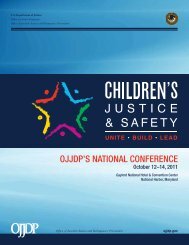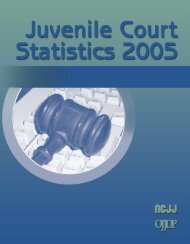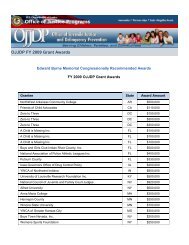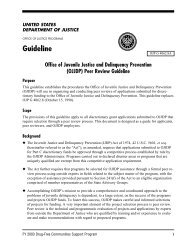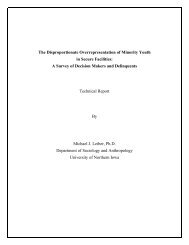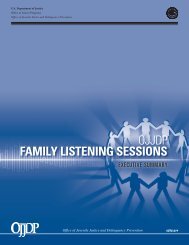Promising Strategies To Reduce Gun Violence - Office of Juvenile ...
Promising Strategies To Reduce Gun Violence - Office of Juvenile ...
Promising Strategies To Reduce Gun Violence - Office of Juvenile ...
You also want an ePaper? Increase the reach of your titles
YUMPU automatically turns print PDFs into web optimized ePapers that Google loves.
Introduction<br />
<strong>Gun</strong> violence represents a major threat to the health and safety <strong>of</strong> all Americans. Every day in the United States,<br />
93 people die from gunshot wounds, 1 and an additional 240 sustain gunshot injuries. 2 The fatality rate is roughly<br />
equivalent to that associated with HIV infection—a disease that the Centers for Disease Control and Prevention<br />
has recognized as an epidemic. In addition to the human suffering caused by these injuries and fatalities, gunshot<br />
wounds account for approximately $40 billion in medical, public service, and work-loss costs each year. 3 In short,<br />
gun violence is a significant criminal justice problem and a public health problem.<br />
In recent years, communities across the country have struggled to develop effective solutions to the problem<br />
<strong>of</strong> gun violence. Many have approached the U.S. Department <strong>of</strong> Justice for help in identifying such solutions.<br />
The Department has developed this publication, <strong>Promising</strong> <strong>Strategies</strong> <strong>To</strong> <strong>Reduce</strong> <strong>Gun</strong> <strong>Violence</strong>, in response to those<br />
requests.<br />
As its name suggests, <strong>Promising</strong> <strong>Strategies</strong> <strong>To</strong> <strong>Reduce</strong> <strong>Gun</strong> <strong>Violence</strong> is designed to provide law enforcement, State<br />
and local elected <strong>of</strong>ficials, prosecutors, judges, school administrators, community organizations, and other local<br />
stakeholders with the tools for fighting firearm violence in their communities. It includes a blueprint for communities<br />
to develop their own comprehensive, strategic violence reduction plan and a wealth <strong>of</strong> practical information<br />
on demonstrated and promising gun violence reduction strategies and programs.<br />
This “toolbox” approach is intended to provide inspiration and guidance as communities take action against<br />
violent crime and, in particular, gun violence. It also is intended to help communities learn from each other’s<br />
successes. <strong>To</strong> promote and facilitate this exchange <strong>of</strong> ideas, contact information is provided for each <strong>of</strong> the<br />
programs pr<strong>of</strong>iled.<br />
Development <strong>of</strong> This Report<br />
<strong>To</strong> develop this Report, the U.S. Department <strong>of</strong> Justice first identified more than 400 gun violence programs<br />
from around the country (see appendix D) by soliciting input from a wide variety <strong>of</strong> sources (see appendix E).<br />
Having cast a wide net to identify candidate programs, the Department then conducted a two-phase telephone<br />
survey. The preliminary survey (see appendix F) allowed the Department to classify each candidate program<br />
according to its level <strong>of</strong> development and to select 89 programs for further study.<br />
These 89 programs were the topic <strong>of</strong> a July 1998 focus group on gun violence reduction strategies, attended<br />
by more than 40 national experts representing a range <strong>of</strong> disciplines from criminology to public health. These<br />
programs were then subjected to further study in the form <strong>of</strong> a followup telephone screening and document<br />
review. This second-phase review yielded the 60 individual programs and comprehensive strategies included in<br />
this Report, each <strong>of</strong> which was designated as “promising” or “demonstrated”; the 10 most promising programs<br />
and strategies were also identified (see appendix F). Finally, site visits were made to eight communities that<br />
have implemented comprehensive plans to reduce gun violence.<br />
Introduction<br />
xiii



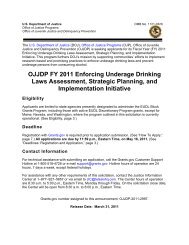
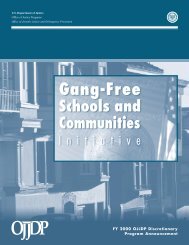
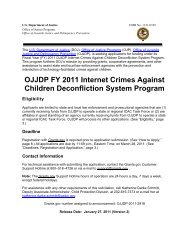
![Chapter 5 [PDF] - Office of Juvenile Justice and Delinquency ...](https://img.yumpu.com/46584340/1/190x245/chapter-5-pdf-office-of-juvenile-justice-and-delinquency-.jpg?quality=85)




